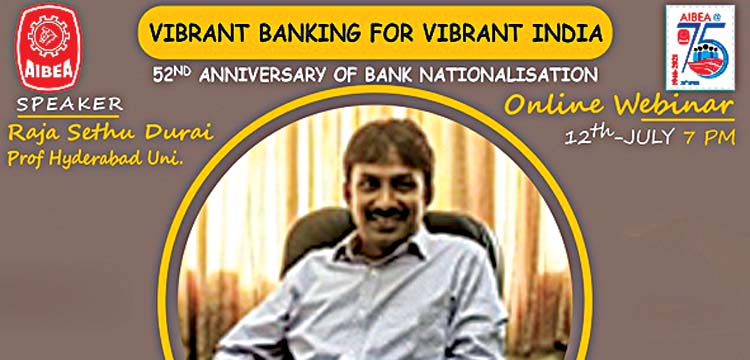New Delhi, Jul 13 (Mayank Nigam) Prof Raja Sethu Durai, Department of Economics from University of Hyderabad (UoH) said the Public sectors will be with the people during hard times and private banks will be there only during boom. Delivering a lecture on ‘Future Banking-an economic perspective’on the 12th day at the month-long AIBEA National Webinars to commemorate the 52nd anniversary of Bank Nationalisation on theme ‘Vibrant Banking for Vibrant India’ and focus ‘people’s money for people’s Welfare on Tuesday night, he dealt with the topic under five major points— Banks’ role as a financial intermediary, technology in banks and impact on employment, non performing assets in public sector banks, monetary policy transmission and future direction of banking sector.
He said there are a lot of concerns because of the technological boom and whether banks would be marginalized from being financial intermediary and whether technology would overtaking the role of banks. The second is that whether the technology in banks would take away the employment potential in the banks. The third part is about the Non-Performing Assets in the public sector banks. The fourth part is about monetary policy transmission. And the last, he dealt about the future direction. Prof Durai pointed out that Banks are a financial intermediary with an objective. Explaining further, he spoke of the objective of a bank and informed that the oldest bank in the world is in Italy, started in 1472 and still in banking business called Monte Dei Paschi Di Siena. It is owned by Government of Italy. The basic objective of this oldest bank has been to extend credit to needy and poor persons and that is nothing but social banking. Social banking is sustainable banking to ensure that basic human needs to be met and then deliver financial services which meet those needs. The basic idea is that there should be a sustainable development in the economy. It is not to make profit but to have social objective, he said.
Global Alliance for Banking on Values (GABV) research shows that the sustainable banking is less volatile. From the social point of view, India’s public sector banks are sustainable banks. But, whether the practices followed in the public sector banks are transparent is a question that needs to be answered. He sais Banks are financial intermediaries with information on risk and credit worthiness. Banks also ensure flow of credit into the financial system. It also assimilates the information asymmetry in the credit market to the common man. The most important characteristic of a bank is the credibility and accessibility. While technology can enhance accessibility but credibility needs strong and stable institutional backing. Hence, the role of financial intermediary is not diminished with technology advancement. But social orientation and sustainable banking will definitely be the ultimate winner as long as there are poor people and needy persons in a country, Prof Durai observed. The UoH Professor said Technological innovation affects every field but it cannot substitute a human capital. Hence, we have to embrace technology and we cannot move forward without technology.
Technology enhances human capital, he said. The level of employment in sub-staff, clerical and officers in public sector banks are more while in private sector banks, the employment of officers is more for the period from 2004-05 to 2019-20. The average growth of public sector banks has been at 3% while it was 12% in private sector banks. The average growth of ATMs between 2012-13 and 2020-21, it is 16%. Hence, it has not displaced the human capital. Hence, technology cannot steal our jobs, he added. Prof Durai said In Public Sector Banks, when NPAs are more, the owner, the Government, doesn’t take the responsibility but they blame others and the previous government. The first stage in a bank is to collect deposits and give advances. The second stage is to see how the advances are performing. The connection between stage one and stage two is very important.
There should be Undesirable occurrence is the Non-Performing Assets. It becomes a burden because banks have to pay interest to the deposits but they won’t have any return from the Non-Performing Assets. In stage 1, both public sector banks and private sector banks are having efficiency of 85% and 90% respectively but in stage 2, the inefficiency creeps in, the same ratio is 59% and 79% as far as efficiency is concerned. Without NPAs, the first stage is 88% and 91% while in the second stage it is 63% and 79% for public sector banks and private sector banks respectively. He said RBI research paper says that the credit channel of monetary transmission was stronger in public sector banks than private banks. During boom times, private banks are more active than the public sector banks but at the time of recession and crisis, public sector banks are more efficient and lend a helping hand than the private sector banks, Prof Durai added.

